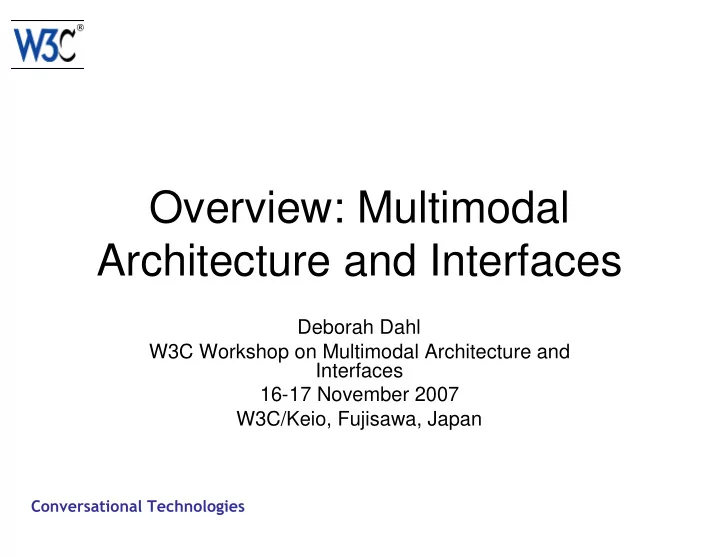

Overview: Multimodal Architecture and Interfaces Deborah Dahl W3C Workshop on Multimodal Architecture and Interfaces 16-17 November 2007 W3C/Keio, Fujisawa, Japan Conversational Technologies
MMI Architecture A loosely-coupled, event-based architecture for integrating multiple modalities into applications • Modality components can be local or distributed • All communication is event-based • Based on a set of standard life-cycle events • Components can also expose other events as required • Encapsulation protects component data • Encapsulation enhances extensibility to new modalities • Represents user inputs in a standard way (EMMA) Conversational Technologies
Constituents • Defines five basic components of an MMI system – Runtime Framework or Browser: initializes application and runs markup – Interaction Manager: coordinates modality components and provides application flow – Modality Components: provide modality capabilities such as speech, pen, keyboard, mouse – Data Model: handles shared data (part of the Interaction Manager) – DCCI (Delivery Context Client Interfaces): device properties and user preferences • Most recent Working Draft, 11 December, 2006 http://www.w3.org/TR/mmi-arch/ Conversational Technologies
MMI Architecture Principles • Runtime Framework communicates with Modality Components through asynchronous events • Modality Components don’t communicate directly with each other but indirectly through the Runtime Framework • Components must implement basic life cycle events, may expose others • Modality components can be nested (e.g. a Voice Dialog component like a VoiceXML <form>) • Components need not be markup-based • EMMA communicates users’ inputs to IM Conversational Technologies
Instantiated MMI Architecture Runtime Framework Interaction Manager (SCXML, including Data Model) DCCI Interaction Manager (SCXML, including Data Model) DCCI Life cycle events Life cycle events Life cycle events + EMMA + EMMA + EMMA Haptic Ink (InkML) Haptic Speech Interaction Ink (InkML) Speech Interaction (VoiceXML + SSML + (VoiceXML + SSML + Life cycle events SRGS+SISR) + EMMA SRGS+SISR) Life cycle events + EMMA Pointing Pointing Keyboard Keyboard Conversational Technologies
Life Cycle Events Event From To Purpose NewContextRequest Modality Runtime Framework Request new context NewContextResponse Runtime Framework Modality Send new context id Prepare Runtime Framework Modality Pre-load markup PrepareResponse Modality Runtime Framework Acknowledge Prepare Start Runtime Framework Modality Run markup StartResponse Modality Runtime Framework Acknowledge Start Done Modality Runtime Framework Finished running Cancel Runtime Framework Modality Stop processing CancelResponse Modality Runtime Framework Acknowledge Cancel Pause Runtime Framework Modality Suspend processing PauseResponse Modality Runtime Framework Acknowledge Prepare Resume Runtime Framework Modality Resume processing ResumeResponse Modality Runtime Framework Acknowledge Resume Data either either Send data values ClearContext Runtime Framework Modality Deactivate context StatusRequest Runtime Framework Modality Check status of MC StatusResponse Modality Runtime Framework Report status Conversational Technologies
Summary • MMI Architecture provides a general, clean interface to a wide range of modality components • EMMA provides a standard and general way of representing user inputs • Very easy to integrate new modalities • Loose coupling and lack of access to internal modality data improves security Conversational Technologies
Recommend
More recommend